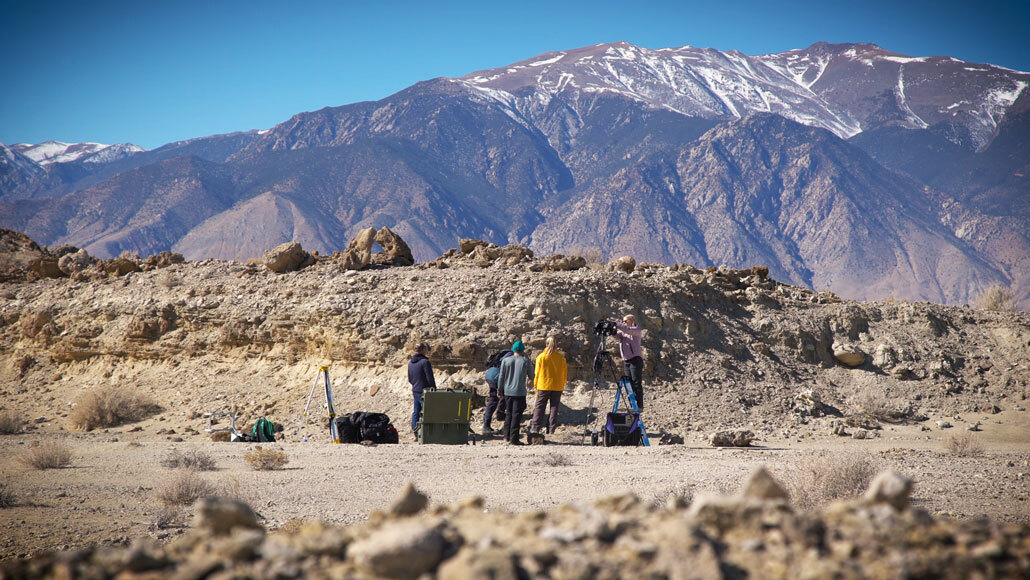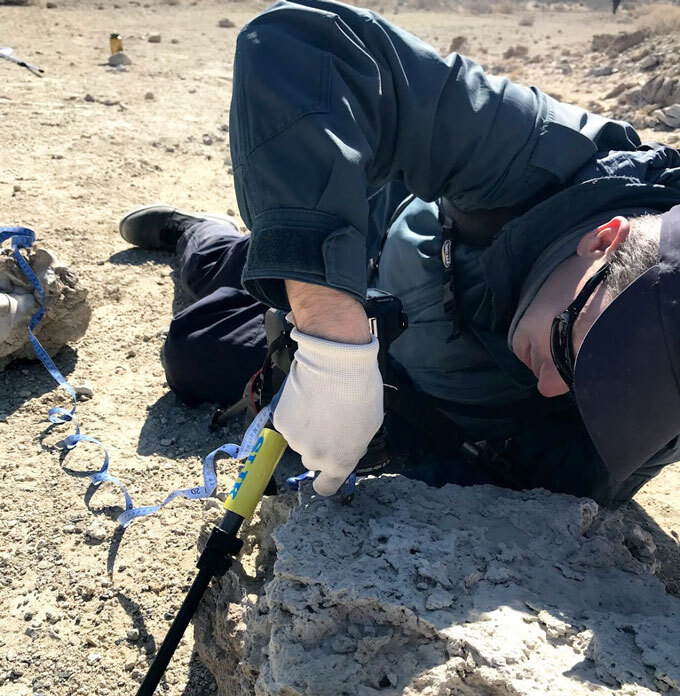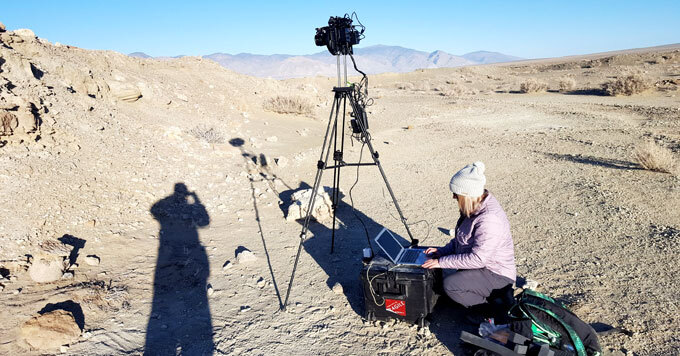To rehearse Perseverance’s mission, scientists pretended to be a Mars rover
It takes effort to make a dry lakebed feel like the Red Planet

Six scientists set up equipment in the Nevada desert in February 2020. Similar equipment will fly to Mars on NASA’s Perseverance rover.
JPL-Caltech/NASA
Megan Barrington watched the sun rise over the rocky outcrop. When light struck at exactly the right angle, she mounted a gizmo that looked like eye exam equipment on a tripod and aimed it at the spot. The goal: gather evidence that this windswept wilderness once teemed with life, and then beam the information to her colleagues back home.
Soon, a version of that setup (minus Barrington) will be deployed on Mars. The state-of-the-art, zoomable, multispectral camera is part of the toolkit on NASA’s Perseverance rover (SN: 7/28/20). “That instrument is going to allow me to look at the mineralogy of Mars at Jezero crater,” the rover’s landing spot, says Barrington, a planetary scientist at Cornell University.
The rover is scheduled to launch to Mars on July 30. A February role-playing exercise in the Nevada desert by Barrington and six colleagues was a kind of dress rehearsal for the rover’s various instruments. Another 150 team members around the world played the “Earth” team during those two weeks, sending commands from remote mission control and receiving data as it would appear coming from the real rover.
“We’re not just simulating a Mars mission,” says engineer Raymond Francis of NASA’s Jet Propulsion Laboratory in Pasadena, Calif., who organized and led the trip. “We’re simulating a specific Mars mission by presenting data … to the people who designed the instrument that will take that data. So the standard is high not to look like clowns.”
Perseverance has the most demanding and ambitious to-do list of any rover yet: seek signs of past Martian life, prepare the way for future human missions and collect at least 20 samples of Martian rock for eventual return to Earth. And that’s just in its first two years. For contrast, Curiosity rover has drilled a few dozen holes over eight years on Mars, and didn’t store any of those samples for later (SN: 7/7/18, p. 8).
The dress rehearsal in the desert will help ensure that when Perseverance lands on the Red Planet in February 2021, its handlers on Earth can get straight to the science.
“We don’t want to get there and learn how to explore Mars while on Mars,” Francis says. “We want [team members] to be ready when the rover hits the ground.”
Water marks the spot
The first order of business was to find the right spot for the dry run. “We had to pick a site that kind of looked like Mars,” Francis says. “The parking lot would not do.” The team wanted the site to look as Mars-like as possible, no factories, footprints or foliage to break the illusion.
An ideal site would have geology that echoed Jezero crater, which is thought to be the remnants of an ancient lakebed and river delta (SN: 11/19/18). It also had to be within a few hours’ drive of JPL, and not totally off the grid — the rover team slept in hotels, ate dinner in restaurants and had reliable Wi-Fi to send data to the Earth team every night.
The final requirement was that it be someplace the Earth team hadn’t seen before. If mission control members recognized the site, they could bias their findings with what they already knew.

“Most of the popular Mars analogs are already well known to the Mars community,” Francis says. “So we had to be a little sneaky.”
Previous exercises, in November 2017 and February 2019, were run in the Mojave Desert in California. For 2020, the rover team headed to Walker Lake in western Nevada. The lake’s water has been receding for thousands of years, so there are spots near the ancient shoreline where the present-day lake is invisible.
Walker Lake’s rocks preserved a cornucopia of biological signals for the ground team to discover: fossilized fish bones and shells of tiny shrimplike crustaceans called ostracods, which are not expected on Mars; and microbial fossils called stromatolites, which could plausibly be found in Jezero crater (SN: 10/17/18).
Toolkit
Francis and his team brought handheld versions of almost all the rover’s instruments to gather whatever data the Earth team requested. They had a drill, handheld spectrometers, lasers, a ground-penetrating radar that they transported in a jogging stroller, plus several elaborate camera setups to represent the rover’s navigation, hazard avoidance and zoomable 3-D science cameras.
Perhaps the most important piece of equipment was the broom used for sweeping away footprints. It became a running joke, Francis says: “We’ve got all this equipment, a multibillion-dollar mission, and it’s all hinging on this 99-cent broom.”
Almost everything went smoothly. But a few days into the mission, Barrington’s zoomable camera had “a major malfunction,” she says. She framed her shot, and…. nothing happened. The camera wasn’t getting any power, she realized. “I took it apart and rewired many pieces, to no avail,” she says.
She and her teammates finally realized one of the power adapters had completely blown. She had to drive two hours to the nearest city to get a new one.
Of course, driving into town to get a new part won’t be an option on Mars. The real camera, called Mastcam-Z, has been through weeks of rigorous testing and calibration, and is probably up to the task. But “we all go into missions knowing that sometimes irreversible mistakes occur,” Barrington admits. “All we can do at that point is use the instruments to the fullest capacity of which they are capable of operating.”

Signs of life, big and small
There was one major giveaway that the team was actually on Earth. “This is very much middle-of-nowhere desert, which is good,” Francis says. But the rover site was mere steps from a U.S. Department of Defense munitions facility, one of the largest in the world.
“It was really something to behold,” Barrington says. “They had hundreds of bunkers lined up in rows as far as you could see…. All of that was one very crooked metal fence away from us.”
More than once, military police showed up to check the team’s credentials. “I had to approach them and say, hello, people with the guns, I need you to stop walking now,” Francis says. “We’re running a Mars rover simulation and we don’t want you to put your footprints in this sand.”
Despite Francis and colleagues’ best efforts, the bunkers showed up in a few photos. The ground team gamely ignored them, apart from a few jokes about SpaceX founder Elon Musk building a Martian city.
By the end of the two-week exercise, the remote science team reviewing the data had noticed the ostracods and fishbones, and started exploring the stromatolites. “They were doing a good job of finding the biomarkers,” Francis says, who now has hope that “if Mars is hiding stromatolites, maybe we’ll see them.”
Coming home to quarantine
The field trip ended on February 27, just as awareness of the novel coronavirus SARS-CoV-2 was rising in the United States. By March 15, JPL told employees to work from home. “We only had a few days together before we were all on remote work,” Francis says.
The pandemic has already contributed to the delay of the launch of the European and Russian ExoMars rover, which was also supposed to launch in July (SN: 3/12/20). If Perseverance misses the late July to early August launch window, the rover can’t head to Mars until 2022.
If the pandemic is still an issue by the time the rover lands in February, Francis doesn’t know what the team will do. “But,” he says, “the good news is the mission is designed for remote operations.”







